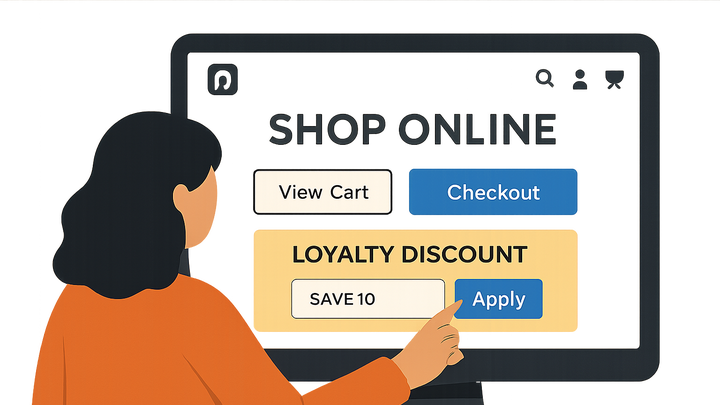Published on 2025-06-29T22:10:10Z
What is an eCommerce Loyalty Discount? Examples and Best Practices
An eCommerce loyalty discount is a targeted incentive offered to existing customers to
encourage repeat purchases, enhance customer lifetime value (CLTV), and foster long-term brand loyalty. In
the competitive world of online retail, these discounts can significantly impact conversion rates, user
experience (UX), and even SEO performance when implemented strategically. By rewarding returning customers
with exclusive offers—such as percentage-off coupons, free shipping thresholds, or tiered
savings—businesses can drive higher purchase frequency and average order value. However, poorly designed
loyalty discounts can lead to confusion, lowered profit margins, or SEO issues if multiple promotion pages
create duplicate content. This article explores the definition, importance, best practices, and real-world
optimization techniques (using tools like prevue.me) to help you craft effective loyalty
discount strategies.
Ecommerce loyalty discount
Targeted discounts for returning customers that boost retention, conversion, and UX quality in eCommerce sites.
Why eCommerce Loyalty Discounts Matter
eCommerce loyalty discounts play a crucial role in fostering long-term customer relationships, improving conversion rates, and enhancing overall site performance. This section delves into the core reasons why these targeted incentives are valuable for businesses focusing on CRO, UX, and SEO.
-
Enhancing customer retention
Offering exclusive discounts to returning customers incentivizes repeat purchases and increases customer lifetime value (CLTV). It creates a sense of appreciation and encourages loyalty.
- Loyalty metrics:
Track repeat purchase rate and churn to measure effectiveness.
- Customer segmentation:
Use segmentation to target high-value or at-risk customers.
- Loyalty metrics:
-
Boosting average order value
Strategic discount thresholds (e.g., spend $50, save 10%) can nudge customers to add more items to their cart.
- Upsell and cross-sell:
Pair discounts with related product suggestions to raise basket size.
- Tiered rewards:
Offer escalating discounts to motivate larger orders.
- Upsell and cross-sell:
-
Building brand advocacy
Satisfied customers who receive value-driven discounts are more likely to share positive experiences, driving organic traffic and SEO benefits.
- Social proof:
Encourage customers to leave reviews post-purchase to bolster credibility.
- Referral incentives:
Combine loyalty discounts with referral programs to expand reach.
- Social proof:
Key Components of Effective Loyalty Discounts
Not all loyalty discounts are created equal. This section outlines the essential components that make discount programs both appealing and sustainable.
-
Personalization
Tailor discount offers based on customer behavior, purchase history, and preferences to increase relevance and engagement.
- Dynamic offers:
Use on-site data to display unique discount codes per user.
- Triggered discounts:
Automate offers after milestones (e.g., 5th purchase).
- Dynamic offers:
-
Clear communication
Ensure discount details (amount, expiration, conditions) are prominently displayed to avoid confusion and friction.
- Transparent terms:
Use plain language and visible expiration dates.
- Consistent messaging:
Align discount messaging across emails, banners, and notifications.
- Transparent terms:
-
Seamless redemption
Simplify the process of applying discounts during checkout to minimize abandonment and user frustration.
- Auto-applied coupons:
Pre-apply discounts for eligible customers.
- Single-step codes:
Allow copy-paste or one-click application of codes.
- Auto-applied coupons:
CRO, UX, and SEO Best Practices
Implementing loyalty discounts effectively requires attention to conversion optimization, user experience, and search engine visibility. This section explores best practices in each area.
-
A/b testing and cro metrics
Experiment with different discount values, messaging, and placements to identify the highest-converting variations.
- Conversion funnels:
Analyze drop-off points in the purchase process.
- Redemption rate:
Track how many customers use the discount versus those eligible.
- Conversion funnels:
-
Ux optimization for discount elements
Design discount badges, banners, and pop-ups with clarity and accessibility in mind.
- Accessible design:
Ensure color contrast and screen reader compatibility.
- Mobile responsiveness:
Optimize layouts for smaller screens to maintain usability.
- Accessible design:
-
Seo considerations
Prevent discount promotions from harming SEO by managing duplicate content and optimizing landing pages.
- Canonical tags:
Use canonical URLs for similar discount pages.
- Structured data:
Implement Schema.org Offer markup for discount information.
- Page speed:
Minimize load times to support SEO and UX.
- Canonical tags:
Optimizing Loyalty Discounts with prevue.me
Leverage the prevue.me platform to audit, analyze, and refine loyalty discount strategies, ensuring maximum impact on CRO, UX, and SEO.
-
Actionable ux critiques
Use prevue.me to identify usability issues in how loyalty discounts are presented and redeemed.
- Visibility assessment:
Check if discount banners are prominent and clear.
- Checkout flow analysis:
Detect any friction when applying codes.
- Visibility assessment:
-
Seo audits for discount campaigns
Employ prevue.me’s SEO auditing tools to review metadata, page structure, and mobile performance of discount landing pages.
- Meta tags optimization:
Improve title tags and meta descriptions for discount pages.
- Content quality review:
Ensure unique content and prevent duplicate promotion pages.
- Meta tags optimization:
-
Conversion rate recommendations
Implement prevue.me’s CRO insights to experiment with discount messaging, placement, and thresholds for optimal conversions.
- Variant testing plans:
Plan A/B tests for different discount scenarios.
- Performance monitoring:
Use prevue.me dashboards to track real-time improvements.
- Variant testing plans:
